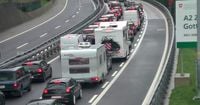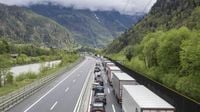The Gotthard Tunnel on the A2 has been closed in both directions since May 2, 2025, due to a broken-down vehicle blocking the passage. This incident has exacerbated the already significant traffic issues that plague the area, leading to long delays for travelers and prompting local politicians to propose new measures to address the ongoing congestion.
According to the Touring Club of Switzerland (TCS), travelers have faced delays of up to 1 hour and 30 minutes at the Gotthard tunnel. For those heading towards Zurich, the TCS recommended an alternative route via the A13 and the San Bernardino tunnel to avoid the chaos. Meanwhile, at the northern portal of the tunnel, traffic was also backed up, with a four-kilometer jam reported between Amsteg and Göschenen UR, causing additional delays of up to 40 minutes.
In response to the persistent traffic jams that plague the Gotthard tunnel, many drivers have increasingly turned to the cantonal roads through the villages of Uri as an alternative route. This has raised concerns among local residents and prompted action from politicians. National Councillors Simon Stadler and Martin Candinas have proposed measures to regulate traffic more effectively, including temporary driving bans by the cantons and requiring navigation system operators to report official road closures.
Simon Stadler has voiced numerous complaints from residents suffering from the traffic diversions. One notable example is a resident from Gurtnellen who has resorted to wearing hearing protection in his home due to the constant noise from passing vehicles. Furthermore, a village doctor reported that he nearly missed an emergency operation due to the traffic delays caused by the diversions.
Stadler's proposal aims to allow cantons to impose temporary driving bans on the north-south axis during severe traffic congestion, but he emphasized that these bans would only be implemented on an hourly basis. His colleague, Martin Candinas, believes that cooperation with navigation system operators is essential. He has suggested that these operators should be obligated to display official road closures to help reduce the volume of traffic diverting through the villages.
However, the Federal Council has expressed skepticism regarding these proposals, recommending their rejection due to legal and practical concerns. They argue that many navigation devices already indicate road closures, and enforcing a legal obligation on foreign navigation system operators could lead to confusion and complications. Additionally, the Federal Council points out that other regions could demand similar measures, complicating the situation further.
Despite the Federal Council's stance, the National Council's Transport Committee has shown support for the proposals, passing Stadler's motion by a narrow majority. The debate over these measures continues, highlighting the ongoing struggle to balance the needs of local residents with the demands of travelers.
In 2023, nearly 6.8 million vehicles traveled through the Gotthard tunnel in both directions, underscoring the significance of this transport route. The sheer volume of traffic often leads to severe congestion, particularly during peak travel times, such as holidays. For instance, during Pentecost 2023, traffic jams stretched up to 20 kilometers, prompting urgent calls for solutions.
Stadler has been advocating for various motions aimed at alleviating the burden of alternative traffic through Uri's villages for years. His proposed changes to the Durchgangsstrassenverordnung would empower cantons to independently close cantonal roads during peak times, allowing for more localized control over traffic management.
As part of these measures, the police would only permit passage through the villages for those with valid reasons, effectively restricting access to residents and service providers. This approach has already been partially implemented during high-traffic days, where security personnel are stationed at highway exits to direct traffic back to the main roads.
However, these personnel can only request that drivers use the highway; they lack the authority to enforce bans or issue fines, leading to tensions and occasional conflicts. Stadler has recounted instances where security personnel have faced hostility from frustrated drivers, highlighting the challenges of managing traffic in such a congested area.
Martin Candinas has taken a different approach to the problem by focusing on the role of navigation systems. He argues that many drivers follow their navigation devices blindly, leading to increased traffic through local villages. By requiring navigation operators to display official road closures, he believes it would be possible to guide drivers back to the main highways during peak times.
Despite these proposals, some lawmakers, such as Aargau SVP National Councillor Benjamin Giezendanner, have expressed doubts about their feasibility. He argues that imposing regulations on navigation companies may not be practical and raises concerns about the implications for local businesses that rely on deliveries. Furthermore, he believes that projecting a regional issue onto a national scale could lead to further complications.
As the National Council prepares to vote on these proposals, the outcome remains uncertain. The Transport Committee's narrow support indicates that opinions are divided, and the debate reflects the broader challenges of managing traffic flow in a region heavily reliant on the Gotthard tunnel.
With the next major holiday approaching, the prospect of another significant traffic jam looms large. As travelers and residents alike brace for the inevitable delays, the urgency for effective solutions continues to grow, leaving many to wonder: what will be done to address the ongoing congestion at the Gotthard tunnel?





